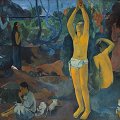Postimpressionism
 1880 - 1900.
1880 - 1900.  Postimpressionism is an umbrella term that encompasses a variety
of artists who were influenced by
Postimpressionism is an umbrella term that encompasses a variety
of artists who were influenced by  Impressionism but
took their art in other directions. There is no single well-defined
style of Post-Impressionism, but in general it is less idyllic and
more emotionally charged than Impressionist work. The classic
Post-Impressionists are Paul Gauguin, Paul Cezanne, and Vincent van Gogh.
Impressionism but
took their art in other directions. There is no single well-defined
style of Post-Impressionism, but in general it is less idyllic and
more emotionally charged than Impressionist work. The classic
Post-Impressionists are Paul Gauguin, Paul Cezanne, and Vincent van Gogh.
Artists and Articles
Paul Cezanne
 Explore the expression and emotion of color with Paul Cezanne, the Post-Impressionist, who achieved perfection
through a unique treatment of space, mass, and color. The French
painter Paul Cezanne is one of the greatest of the
Post-Impressionists, whose works and ideas were influential in the
aesthetic development of many 20'th century artists and art movements,
especially Cubism. It is the tension between actuality and illusion,
description and abstraction, reality and invention, that makes
Cezanne's most unassuming subjects so profoundly satisfying and
exciting, and which provided a legacy for a revolution of form that
led the way for modern art. By the time of his death in 1906,
Cezanne's art had begun to be shown and seen across Europe, and it
became a fundamental influence on the Fauves, the Cubists, and
virtually all advanced art of the early 20th century.
Explore the expression and emotion of color with Paul Cezanne, the Post-Impressionist, who achieved perfection
through a unique treatment of space, mass, and color. The French
painter Paul Cezanne is one of the greatest of the
Post-Impressionists, whose works and ideas were influential in the
aesthetic development of many 20'th century artists and art movements,
especially Cubism. It is the tension between actuality and illusion,
description and abstraction, reality and invention, that makes
Cezanne's most unassuming subjects so profoundly satisfying and
exciting, and which provided a legacy for a revolution of form that
led the way for modern art. By the time of his death in 1906,
Cezanne's art had begun to be shown and seen across Europe, and it
became a fundamental influence on the Fauves, the Cubists, and
virtually all advanced art of the early 20th century.
 The Barque of Dante (After Delacroix) (1870)
© Paul Cezanne
The Barque of Dante (After Delacroix) (1870)
© Paul Cezanne
 The Walk (1870)
© Paul Cezanne
The Walk (1870)
© Paul Cezanne
- Paul Cezanne Art, $25
 (125 pictures)
(125 pictures)
- Paul Cezanne. Life and work.
- Paul Cezanne. Starting the modern art.
Paul Gauguin
 Paul Gauguin, one of the leading French painters
of the Postimpressionism period, whose development of
a conceptual method of representation was a decisive step for
20th-century art. Gauguin's paintings are powerful, while the subject
matter is distinctive, the scale is large, and the compositions are
simplified. Gauguin implied the qualities of expressive color, denial
of perspective, and thick, flat forms. "The further I go, the more I
feel sure that thoughts can be expressed by something quite different
from literature," Gauguin wrote. Gauguin's artistic development of a
conceptual method of representation was important for the history of
art as it moved into the twentieth century. Painters no longer aimed
at depicting the outer world but at rendering their inner dreams by
symbolic allusion and decorative form. Line and color developed their
powers of expression, taking inspiration in global art.
Paul Gauguin, one of the leading French painters
of the Postimpressionism period, whose development of
a conceptual method of representation was a decisive step for
20th-century art. Gauguin's paintings are powerful, while the subject
matter is distinctive, the scale is large, and the compositions are
simplified. Gauguin implied the qualities of expressive color, denial
of perspective, and thick, flat forms. "The further I go, the more I
feel sure that thoughts can be expressed by something quite different
from literature," Gauguin wrote. Gauguin's artistic development of a
conceptual method of representation was important for the history of
art as it moved into the twentieth century. Painters no longer aimed
at depicting the outer world but at rendering their inner dreams by
symbolic allusion and decorative form. Line and color developed their
powers of expression, taking inspiration in global art.
 Mette Asleep on a Sofa (1875)
© Paul Gauguin
Mette Asleep on a Sofa (1875)
© Paul Gauguin
 Three Tahitians (1898)
© Paul Gauguin
Three Tahitians (1898)
© Paul Gauguin
 The Seine, Pont d'Iena (1875)
© Paul Gauguin
The Seine, Pont d'Iena (1875)
© Paul Gauguin
- Paul Gauguin Art, $25
 (125 pictures)
(125 pictures)
- Paul Gauguin. Life and work.
Vincent van Gogh
 Vincent van Gogh, is generally considered to be
the greatest Dutch painter after Rembrandt, and, with Cezanne and
Gauguin, the greatest of Post-Impressionist
artists. Vincent van Gogh created Postimpressionism
and powerfully influenced the current of Expressionism in modern art,
though he had little success during his lifetime. Van Gogh produced
all of his 900+ paintings and 1100+ drawings during a period of only
10 years before he succumbed to mental illness, possibly bipolar
disorder, and committed suicide. The striking, bold, intense colors,
the emphatic brushwork, and contoured forms of his work are highly
expressive, even emotional. Van Gogh used the symbolic and
expressive values of colors for expressing emotions rather than, as
did the Impressionists, for the reproduction of visual appearances,
atmosphere, or light. The term Post-Impressionist does, however,
acknowledge that Impressionism had shaped this
artist.
Vincent van Gogh, is generally considered to be
the greatest Dutch painter after Rembrandt, and, with Cezanne and
Gauguin, the greatest of Post-Impressionist
artists. Vincent van Gogh created Postimpressionism
and powerfully influenced the current of Expressionism in modern art,
though he had little success during his lifetime. Van Gogh produced
all of his 900+ paintings and 1100+ drawings during a period of only
10 years before he succumbed to mental illness, possibly bipolar
disorder, and committed suicide. The striking, bold, intense colors,
the emphatic brushwork, and contoured forms of his work are highly
expressive, even emotional. Van Gogh used the symbolic and
expressive values of colors for expressing emotions rather than, as
did the Impressionists, for the reproduction of visual appearances,
atmosphere, or light. The term Post-Impressionist does, however,
acknowledge that Impressionism had shaped this
artist.
 Starry Night (1889)
© Vincent van Gogh
Starry Night (1889)
© Vincent van Gogh
 Landscape with House and Ploughman (1889)
© Vincent van Gogh
Landscape with House and Ploughman (1889)
© Vincent van Gogh
- Vincent van Gogh Art, $25
 (100 pictures)
(100 pictures)
- Vincent van Gogh. Life and work.
- Vincent van Gogh. The greatest of Postimpressionists.
- Vincent van Gogh. Study of art, paintings, and works.
More
Movements
 Art Encyclopedia A world history of art in articles.
Art Encyclopedia A world history of art in articles.
Renaissance
Baroque
Romanticism
Impressionism
Postimpressionism
Modernism
Postmodernism
Art
 Art Wallpapers Art image collections for your desktop.
Art Wallpapers Art image collections for your desktop.
